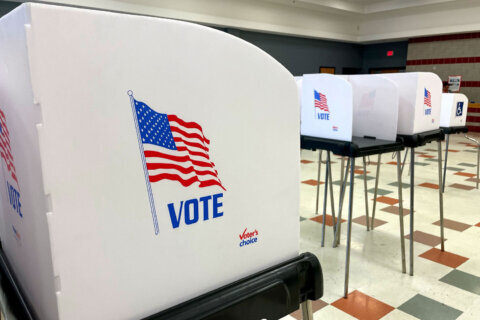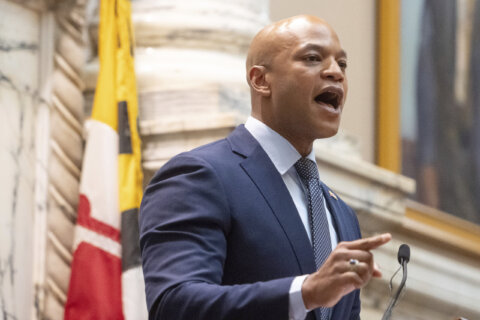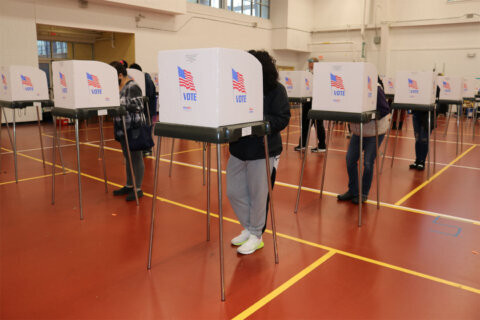Editor’s note: The polls in Maryland are now closed. Read about the results in Maryland’s House races and the results for state and ballot questions.
In Maryland, early voting kicked off Monday, Oct. 26, and runs up until Election Day.
Election officials have encouraged people to vote by mail because of the COVID-19 pandemic, and the state has seen a wave of mail-in ballots come in so far.
From where to vote to what’s on the ballot, here’s everything you need to know about Election Day 2020 in Maryland.
What to know about early voting
Early in-person voting began Monday, Oct. 26 and runs for the following eight days through Nov. 2.
Marylanders have turned out for early voting in record-breaking numbers. As of Nov. 1, a total of 853,014 voters had cast ballots at early voting sites, according to data from the Maryland State Board of Elections.
Early voting locations are open from 7 a.m. to 8 p.m.
Voters can cast their ballots at any authorized early voting center in their jurisdiction.
There are a total of 81 early voting centers across Maryland, including 11 in Montgomery and Prince George’s counties, seven in Anne Arundel County, four in Howard County and two in Charles County.
You can find a full list of early voting centers here.
You can also use the state board of elections “Voting Center Lookup” Tool to find the closest place to vote.
Don’t be alarmed if you see long lines. Early voting centers are practicing social distancing of 6 feet, which could make lines appear longer than usual.
Election officials recommend visiting an early voting center between the hours of 10 a.m. and 2 p.m. as having the least crowds.
Still need to register to vote? Same-day voter registration is available at early voting centers.
In order to register during early voting, you have will have to prove Maryland residency, which could include a state-issued driver’s license or ID card, or a paycheck, bank statement, utility bill or other government document that includes the voter’s name and new address.
It’s important to note, voters cannot “trade in” a mail-in ballot at an early voting center and then vote in person. If a voter has already requested or received a mail-in ballot, the voter will have to cast a provisional ballot. The provisional ballot will be counted, but it will be held until election officials confirm the voter did not also return a mail-in ballot.
Voters can, however, drop off mail-in ballots at early voting centers provided their ballot is properly sealed in the return envelope that came with the mail-in ballot. Don’t forget to sign the oath on the return envelop for the ballot to be counted.
- Sign up for WTOP’s elections newsletter
- What’s on the ballot: Prince George’s Co. voters weigh in on 5 bond issues
- 4 Montgomery County ballot questions: What you need to know
- DC voter guide
- Maryland voter guide
- Virginia voter guide
- Presidential Election News
- Congressional Election News
- Local Politics and Elections News
What you need to know about mail-in voting
Maryland has urged voters to vote by mail this year because of the COVID-19 pandemic, and more than 1.6 million Marylanders have requested mail-in ballots.
As of Nov. 1, more than 1.3 million mail-in ballots have already been received by the board of elections.
If you still have your mail-in ballot at home, here’s what you should know:
Filling out and returning your ballot
The board of elections has these reminders for completing your ballot:
- Use black ink to mark your ballot
- Sign the oath on the return envelope, but do not sign the ballot
- Seal your return envelope
- Send your ballot using the postage-paid return envelope.
If you choose to have your mail-in ballot mailed via postal mail, it will come with a prepaid postage return envelope. If you choose to have your ballot emailed to you, you will need to print your ballot and then pay the postage yourself to return it.
For those who print out their own ballots off a computer (either because it was emailed to them or they downloaded it online), make sure you also print out the oath that comes on a separate page, sign it, and include it when you return the ballot. Ballots received through the mail have that oath on the outside of the return envelope.
Ballot drop-off boxes
At this point, election officials recommend you drop off your completed ballot at a ballot drop box. Overall, there are 284 ballot drop boxes throughout Maryland, the board of elections said.
The drop boxes will be open until 8 p.m. on Election Day.
You can find a full list of ballot drop-off boxes here.
The state Board of Elections says ballots left in the boxes are retrieved at least twice a day and are “monitored and secured by trusted election officials.”
In an effort to help local election boards deal with an expected surge of mail-in ballots, the board approved rules in August allowing election officials to start tallying up mail-in ballots starting Oct. 1. However, the results won’t be announced until polls close on Election Day.
If you decide to mail your ballot, it must be postmarked by Election Day, which is Nov. 3. Putting your ballot in a mailbox on Nov. 3 does not necessarily mean it is postmarked. All ballots received by the board of elections by Nov. 13 will be counted.
Voting on Election Day
While elections officials are urging people to vote by mail because of the COVID-19 pandemic, there are still places to vote in person on Election Day.
Overall, about 350 vote centers will be open across the state, including the early voting centers. Voters will be able to cast their ballots at any vote center in the county where they are registered to vote. Residents of Baltimore City can cast their ballots at any vote center in the city.
The vote centers will be open from 7 a.m. to 8 p.m. on Election Day.
There will be some coronavirus-related changes so voters will be kept 6-feet apart, and the number of people allowed inside will be limited, which may result in lines and wait times.
On Election Day, the best time to vote is between 10 a.m. and 3 p.m. because that’s when lines are usually the shortest.
If you still need to register to vote, you can also do that on Election Day.
You have will have to prove Maryland residency, which could include a state-issued driver’s license or ID card, or a paycheck, bank statement, utility bill or other government document that includes the voter’s name and new address.
It’s important to note, voters cannot “trade in” a mail-in ballot at a voting center and then vote in person. If a voter has already requested or received a mail-in ballot, the voter will have to cast a provisional ballot. The provisional ballot will be counted, but it will be held until election officials confirm the voter did not also return a mail-in ballot.
Voters can, however, drop off mail-in ballots at early voting centers provided their ballot is properly sealed in the return envelope that came with the mail-in ballot. Don’t forget to sign the oath on the return envelop for the ballot to be counted.
You can find a full list of Election Day vote centers here.
What’s on the ballot?
There’s a range of things on the ballot that voters will weigh in on.
Congressional races
In addition to the presidential contest, all of Maryland’s eight U.S. House seats are up for grabs. Democrats hold seven of the eight seats.
District 1
- Republican — Andy Harris (incumbent)
- Democratic — Mia Mason
District 2
- Republican — Johnny Ray Salling
- Democratic — C.A. Dutch Ruppersberger (incumbent)
District 3
- Republican — Charles Anthony
- Democratic — John Sarbanes (incumbent)
District 4
- Republican — George E. McDermott
Democratic — Anthony G. Brown (incumbent)
District 5
- Republican — Chris Palombi
- Democratic — Steny H. Hoyer (incumbent)
District 6
- Republican — Neil C. Parrott
- Democratic — David J. Trone (incumbent)
- Green — George Gluck
District 7
- Republican — Kimberly Klacik
- Democratic — Kweisi Mfume (incumbent)
District 8
- Republican — Gregory Thomas Coll
- Democratic — Jamie Raskin (incumbent)
Statewide questions
In addition, there are a number of state and local measures.
Statewide, voters will weigh in on two ballot questions.
Question 1 is a constitutional amendment that would change the state’s budget process. The measure, which is backed by Democrats in the Maryland House and Senate, would allow the Maryland General Assembly to increase, decrease or add items to the budget submitted by the governor as long as it doesn’t exceed the total amount proposed by the governor. The measure wouldn’t take effect until 2024.
Question 2 is a referendum that asks voters to weigh in on whether to authorize sports and events betting at licensed facilities. If approved by voters, the referendum authorizes the General Assembly to approve legislation that would allow the State Lottery and Gaming Control Commission to issue sports betting licenses.
In 2018, the U.S. Supreme Court ruled that a federal ban on sports betting was unconstitutional. Since then, a number of states have legalized sports betting. Both D.C. and Virginia have legalized sports betting since the Supreme Court decision.
In Maryland, sports betting is still illegal.
Local ballot measures
There are also a number of local ballot measures.
Montgomery County
There are competing measures on the ballot for limiting property tax increases and for changing the structure of the Montgomery County Council.
Question A — This proposal, which is backed by the Montgomery County Council, would remove an inflation-pegged cap on property tax revenue collected but would instead cap the property tax rate at the previous year’s level unless the council voted to override it by a unanimous vote.
Question B — This measure would continue the cap on property tax revenue increases at the level of inflation but would prohibit the county council from overriding the formula. Currently, property tax revenue is pegged to inflation but the county council can override it by a unanimous vote.
Question C — This measure would expand the Montgomery County Council from nine members to 11 by increasing the number of council districts from five to seven. The number of at-large council members would remain unchanged.
Question D — This proposal would change the county council structure by doing away entirely with at-large seats. The total number of council members would remain at nine, but they would all be elected by geographical district.
See the full Montgomery County ballot.
Prince George’s County
(Editor’s note: This section has been updated to correct the designations of the ballot questions.)
In Prince George’s County, there are five bond issues on the ballot.
Question A is a $178.15 million bond issue that would fund public works and transportation projects.
Question B is a nearly $28.83 million bond issue to finance the design and construction of library projects.
Question C is a nearly $44.48 million bond issue to finance construction projects at public safety and fire department facilities.
Question D is a $133 million bond issue to finance construction and rehabilitation projects at county buildings.
Question E is a $121.7 million bond issue to help fund projects for community college facilities.
See the full Prince George’s County ballot.
Anne Arundel County
In Anne Arundel County, there are seven questions on the ballot, including a measure that would require key county executive appointments — including county attorney, chief of police and fire chief — to be confirmed by the county council.
Another measure would beef up the power of the county auditor to have access to county records and to conduct investigations into waste, fraud and abuse.
See the full Anne Arundel County ballot.
Baltimore County
Voters in Baltimore County will weigh in on six bond issues.
See the full Baltimore County ballot.
Frederick County
In Frederick County, voters will see four ballot questions. They include a measure requiring the Frederick County executive to provide any information requested by an individual member of the county council in their official duties; and measures dealing with vacancies on the county council and in the position of county executive.
See the full Frederick County ballot.
Howard County
Voters in Howard County will weigh in on three ballot questions, including one allowing the county council to set dates for drawing new council district borders.
County residents are also being asked to amend Howard County’s charter to expand and clarify employment discrimination policies. Under the change, discrimination on the basis of a person’s disability, color, national origin, immigration status, age, occupation, marital status, sexual orientation, gender identity or expression, family status, or personal appearance would be prohibited. The measure would no longer include the word “sex.” The change also would make clear the county could still not make an employment decision based on a person’s political or religious opinions or associations or race.
See the full Howard County ballot.








